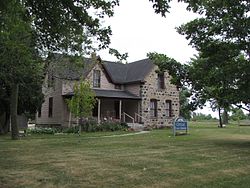
Harbor Beach is a city in Huron County in the U.S. state of Michigan. The population was 1,703 at the 2010 census.
The Thumb is a region and a peninsula of the U.S. state of Michigan, so named because the Lower Peninsula is shaped like a mitten. The Thumb area is generally considered to be in the Central Michigan region, east of the Tri-Cities and north of Metro Detroit. The region is also branded as the Blue Water Area.
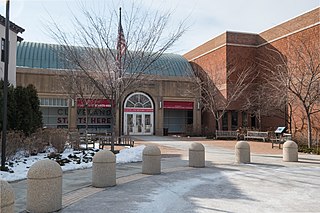
The Western Reserve Historical Society (WRHS) is a historical society in Cleveland, Ohio. The society operates the Cleveland History Center, a collection of museums in University Circle.

The Whaling Museum & Education Center, formerly known as The Whaling Museum, is a maritime museum located in Cold Spring Harbor, New York dedicated to exploring the local history and impact of the whaling industry, the maritime heritage of Long Island, and the relationship between people and the ocean.

Shelburne Museum is a museum of art, design, and Americana located in Shelburne, Vermont, United States. Over 150,000 works are exhibited in 39 exhibition buildings, 25 of which are historic and were relocated to the museum grounds. It is located on 45 acres (18 ha) near Lake Champlain.

19th Century Willowbrook Village was an open-air museum encompassing a former 19th-century village in Newfield, Maine. It is located north of the town center on Elm Street, on approximately 10 acres (4.0 ha), with 34 buildings. It was open 10 a.m. to 5 p.m., 5 days each week from the Saturday of Memorial Day weekend through October, closed Tuesdays and Wednesdays. Much of the museum property is listed on the National Register of Historic Places as the Newfield (Willowbrook) Historic District.

The Schoolhouse Children's Museum & Learning Center is located in a historic school building, the Boynton School, at 129 East Ocean Avenue in Boynton Beach, Palm Beach County, Florida.

The New Hampshire Farm Museum is a farm museum on White Mountain Highway in Milton, New Hampshire, United States. Three centuries of New Hampshire rural life are presented in the historic farmhouse. The museum includes a 104-foot-long (32 m) three-story great barn with collection of agricultural machinery, farm tools, sleighs and wagons. There are also live farm animals, a nature trail and a museum shop. The museum is located on the former Plumer-Jones Farm, a traditional series of connected buildings with farmhouse dating to the late 18th century and barns dating to the mid 19th century, which was listed on the National Register of Historic Places in 1979.
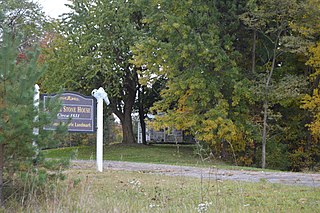
Judge William Shaw Anderson House is a building in Austintown, Ohio, listed in the National Register of Historic Places on 1976-03-17. It is also known as the "Strock Stone House."
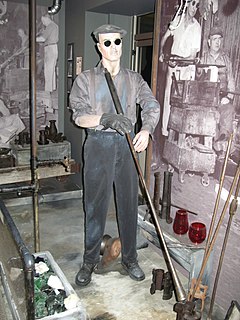
The Wallaceburg and District Museum is located in Southern Ontario in the town of Wallaceburg. Located a half-block from the banks of the Sydenham River, the museum occupies the former Wallaceburg Hydro Office at 505 King Street. The museum opened on June 29, 1984. The museum documents the beginning of the Wallaceburg community from the founding of the Baldoon Settlement by Lord Selkirk in 1804 to its success as an industrial hub in the mid-1900s.

The Harbor Beach Lighthouse is a "sparkplug lighthouse" located at the end of the north breakwall entrance to the harbor of refuge on Lake Huron. The breakwall and light were created by the United States Army Corps of Engineers to protect the harbor of Harbor Beach, Michigan, which is the largest man-made freshwater harbor in the world. Harbor Beach is located on the eastern edge of the Thumb of Huron County, in the state of Michigan.

The Gibbs Farm is a museum in Falcon Heights, Minnesota, United States. The site was once the farmstead of Heman Gibbs and Jane DeBow, first built in 1854; the existing farmhouse includes the small, original cabin. The museum seeks to educate visitors on the lives of 19th-century Minnesota pioneers and the Dakota people who lived in southern Minnesota before the arrival of Europeans.
Heritage Village Museum is a recreated 1800s community in Southwestern Ohio, in the United States. The village contains 13 historic buildings from around the Cincinnati area; they were moved here to save them from destruction. The village is located within Sharon Woods Park in Sharonville, Ohio.
Grey Roots Museum and Archives began as a County museum in 1955. Since then it has taken a large role in preserving the history and promoting the heritage of Grey County.

The Eagle Harbor Schoolhouse is a school located at the corner of Third and Center Streets in Eagle Harbor, Michigan, United States. It is significant as the location where Justus H. Rathbone was first inspired to write the ritual which was the basis of the Order of the Knights of Pythias. The schoolhouse was designated a Michigan State Historic Site in 1971 and listed on the National Register of Historic Places in 1972. It is also known as the Pythian Shrine and as the Rathbone School.
The Lake Odessa Area Historical Society and Museum in downtown Lake Odessa, Michigan, is home to a variety of historical items pertaining to the Lake Odessa area including an impressive collection of artifacts from a German POW camp that existed near Lake Odessa area during World War II, a Pere Marquette Railroad Depot built in 1887, a restored Grand Trunk Caboose, various local historical displays, the Ionia County Genealogical Library, and the Hosford House. Operations are determined by a board of directors but the historical society is solely managed by the president, John Waite. The museum is a private, non-profit museum completely self-funded through various events and through philanthropists.

Manatee Village Historical Park is an open-air museum located in Bradenton, Florida, at 1404 Manatee Avenue East. The museum is designated as a National Historic Site.
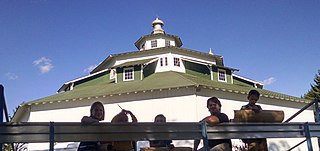
The Thumb Octagon Barn is an historic and unique barn located outside Gagetown, Michigan.
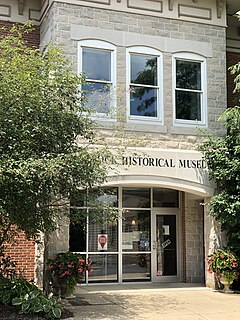
The Hancock Historical Museum is a museum in Findlay, Ohio dedicated to the preservation of the history of Hancock County, Ohio. It is a non-profit, privately funded museum located in the Hull-Flater House at 422 West Sandusky Street and is a member of the Ohio Local History Alliance.
The Pine Grove Historical Museum is located in Pontiac, Michigan and operated by the Oakland County Pioneer and Historical Society. The museum features the home of former Michigan Governor Moses Wisner. The four acre-plus property also includes several outbuildings, including a summer kitchen, a smokehouse and a root cellar.
